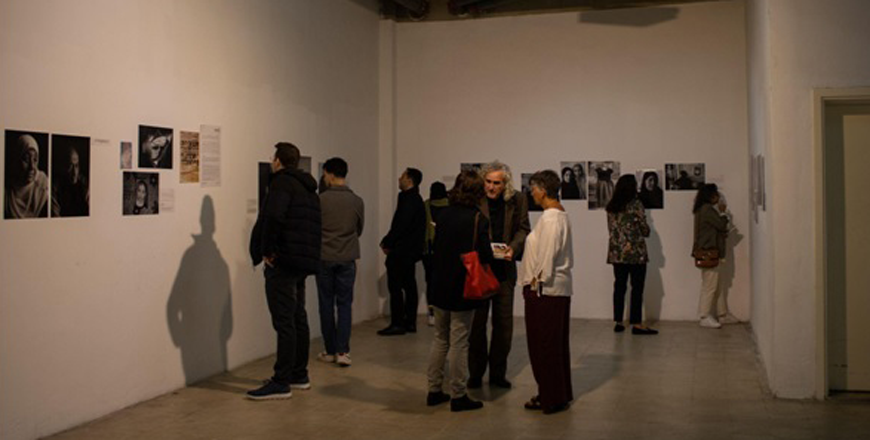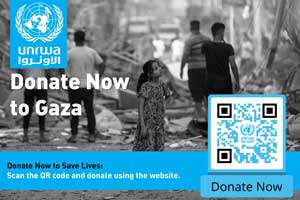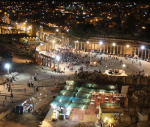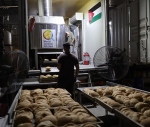You are here
Photography festival in Amman captures stories from around world
By Hanna Davis - Apr 14,2025 - Last updated at Apr 14,2025

The opening of the Image Festival Amman at Zara Centre in Amman on April 10, 2024 (Photo by Hanna Davis)
AMMAN — The bland, white walls at Amman’s Zara Centre came alive on Thursday evening, at the opening of the Image Festival Amman, in its 13th edition.
As the hundreds of attendees strolled through the 13 photo exhibitions, they glimpsed into foreign countries, witnessed quests for loved ones, and beheld stories of rehabilitation, loss, and survival.
At the entrance to the gallery, 19-year-old photographer Ahmed Buttma stood in front of his exhibition. “This is the experience of someone from the West Bank,” he told The Jordan Times.
Black-and-white photos of Israeli checkpoints and soldiers were pasted onto a glass barrier, blocking entry into a room full of colourful images of mountains, rivers, and beaches in occupied Palestine, or present-day Israel.
The young photographer is from Battir, a Palestinian village in Bethlehem. “Our life is just behind this wall, which has been stolen from us,” he added, gesturing the photos beyond the glass barrier.
He and his colleague, Nael Ikhmais, whom he produced the exhibition with, travelled from their village, facing lengthy wait times at Israeli checkpoints and piles of paperwork along the way, to attend the Image Festival in Amman.
“A lot of people don’t know anything about the West Bank or about the life we face, so we’re showing you the experience,” he said.
International artists
The two young Palestinian photographers were among the 25 photographers selected for the Image Festival, its curator, Linda Khoury, told The Jordan Times. She said they received work from “all over the world,” Morocco, Tunisia, Algeria, Yemen, Palestine, and France, just some of the countries represented.
The Image Festival, organised by Darat Al Tasweer, will run until May 10. In addition to near-daily photography exhibition openings, the festival also offers workshops, meetings with guest photographers, portfolio readings by professionals, residential programmes, publications, and photography competitions.
For the past two years, since the war in Gaza, Khoury said she has boycotted funding from donors who “did not support the Palestinian cause”. This meant the already-scarce funding was even lower than previous years.
However, Khoury said that the turnout has still been “amazing”. “At the end of the day, it’s a decision I decided to take and would like to continue,” she said.
The internationally-recognised photojournalist, Ed Kashi, has come to Amman to participate in the festival, for the third time. This year, he is displaying his work at Nofa Creative Space in Jabal Amman, on an underreported and deadly kidney disease.
He is also leading an intensive photography workshop for festival participants. “It’s one of the beautiful aspects of being a photographer and doing this work, you get the chance to meet young photographers,” he told The Jordan Times.
“There’s an exchange that I love, I learn a lot, and I’m hopefully doing the same for them,” he said.
‘The strength they displayed amazed me’
Back at the Zara Centre, French photographer Sandro Basili, 27, guided visitors through his photo exhibition, “A Quest No Family Should Ever Have to Endure”, capturing the difficult search for those imprisoned under the former Assad government.
Outside a small room, a few photos taken on the grounds of Syria’s notorious Sednaya Prison hung under warm lighting. In one portrait, a woman’s wrinkled hands grip onto a small photo of a mid-aged man.
Inside the small room, the cold, white lighting and scuffed cement floor evoked the uncomfortability of a hospital. In one photo displayed, an elderly man walks through the corridors of a hospital in Damascus, hoping to identify bodies. In another, a family looks at posters of disfigured bodies.
“Families, with the thin hope they could find people alive, were still looking,” Basili told The Jordan Times. “The strength they displayed amazed me,” he said.
‘This place holds a special meaning’
Near Basili’s exhibition, another photo series portrayed five ex-convicts in Lebanon, imprisoned on drug charges.
“I worked with ex-prisoners when they were released from jail, to show how they would continue their lives, without a support system or rehabilitation programme,” the Lebanese photographer, Elsie Haddad, 43, told The Jordan Times.
Ahmad, one of the ex-convicts Haddad worked with, stands in one photo at Beirut’s waterfront, his leg wrapped in a green cast.
He leans on a crutch as he watches a group play volleyball on the sandy shore. Her own brother was arrested on a drug charge during the project. The young man stands in one portrait, his face covered by a cloud of smoke.
Down the hall, 26-year-old Haitam Nsais had displayed his photos of an historic seaside promenade in the Moroccan coastal city of Larache. The spot was treasured by locals and visitors, Nsais told The Jordan Times, a peaceful space to escape the bustle of the city.
However, it suffered from neglect and damage, and instead of considering general repairs, Nsais said the authorities were discussing demolition.
“If this happens, it will erase the historical significance of what is one of the best places in Larache,” Nsais said.
“This place holds a special meaning for me; it is close to my heart because it ties back to my childhood memories with my father,” Nsais continued, as he gazed at his photo of a man taking a photo of his daughter beside the sea.
















